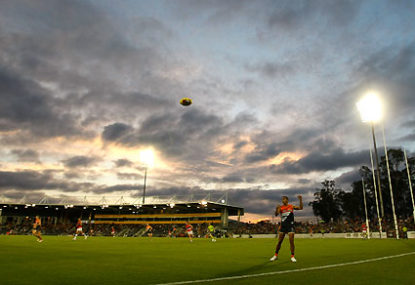With the AFL on the verge of seeing its $100 million investment in the GWS Giants reach its peak within its fifth season, it has all but confirmed that it made the wrong location choice for its 18th team.
This is both from a fan and business perspective.
The case for choosing a second Sydney side over Tasmania has always been justified as a business decision.
Western Sydney’s superior population, local corporate market, and capacity to provide a stronger TV presence in Australia’s largest city meant that Tasmania stood no chance in the eyes of the AFL.
Tasmania is a captive AFL market, which in business terms can be considered a negative when you are looking to grow your product. Businesses striving for growth are addicted to new markets like Western Sydney that have four times the population of its counterpart and growing. But this addiction has proven to be a trap for many.
The AFL’s foray into Western Sydney is similar to those international based engineering firms looking to grow by capitalising on the Australian mining boom while their homeland was in recession.
Many of these ventures failed due to the timing, arriving when the boom was in decline, and an overestimation the demand for their services with the market already saturated.
The timing of the Giants was challenged with the unexpected arrival of the Western Sydney Wanderers, which in turn saturated with the city with football code franchises.
Further, the AFL wrongly ignored the positives of the captive market and completely overestimated the potential of its product in Sydney.
This was highlighted by contributing to a $65 million upgrade to a stadium that has still not attracted a crowd that has exceeded its previous capacity of 21,500. Western Sydney also was not a new AFL market as the Swans have been there since 1982, meaning it is very easy for someone with a basic level of understanding of Sydney to know big the Giants could be, and we are seeing it right now.
They are destined to be the Australian sporting equivalent of the London Broncos in the English Super League, but with significantly more money wasted.
The conditions could not have been more ripe for the Giants fan-base to break out to its peak and justify the AFL’s ambitious investment.
This September, Sydney will record its lowest ever aggregate attendance for NRL finals matches (just 50,000 over two matches) and most of the western Sydney NRL clubs performed poorly this season.
Based on the ticket sales this week and TV viewership to date, it is now apparent the appetite for the Giants club is as underwhelming as many originally anticipated.
It is difficult to see how the AFL have or will ever make any profitable return on their investment in the Giants.
Claims that the addition of GWS has resulted in in a $1.2 billion TV rights contract are overblown given it is hard to see how Tasmania would have significantly compromised that figure, especially to the extent of covering the difference of the $100 million investment.
The NRL also secured a $1 billion contract with one less match per round, only one team in Melbourne and without a market presence in Adelaide and Perth.
The provision of two teams in non-traditional markets doesn’t appear to be the secret recipe for making significant increases to TV revenue. Rather it is the product that you put to the markets you are in.
TV ratings for Giants games in Sydney are so low you would imagine they would be the same if they were watching a Tasmanian side.
You could argue that if it were not the Giants but Tasmania hosting the Bulldogs at Spotless Stadium for this preliminary final you would get the same crowd on Saturday night.
A Tasmanian AFL side presented an opportunity to create an Australian version of the Green Bay Packers, or at least another Geelong Cats, being a regional based side with a fan-base that could rival the capital city markets.
A club that could have been everyone’s second team to support and one that would not require any near the amount of financial life-support from the AFL, enabling the game to provide better support to other struggling aspects of the game like Queensland and grass roots.
The biggest sporting story in Australia this year could well have been the Tasmanian AFL side making a charge to the AFL grand final if the Giants were based there in 2012.
It would have been priceless to see the whole of Tasmania joining Bulldogs members scrambling to get their hands on the 25,000 tickets available at Blundstone Arena.
Sports fans across the nation would be glued to watching what would be historic and palpable scenes in Hobart. Tasmanian AFL merchandise would be appearing across the nation from ex-pats who have settled on the mainland.
Instead, we have Bulldogs fans lining up to outnumber Giants fans at a soulless sporting venue in Sydney. While this is a great moment for the game, it is mostly driven by the story of the Bulldogs, not the Giants as sporting fans are in the most part intelligent enough to know what is fake and what is real.
Passionate fans with critical masses are the main ingredients for successful sporting franchises and business models should operate with the approach of the more the merrier.
The GWS Giants have proven that they will never be able to replicate anything of the magnitude of what a Tasmanian side would bring to the AFL.






























































































